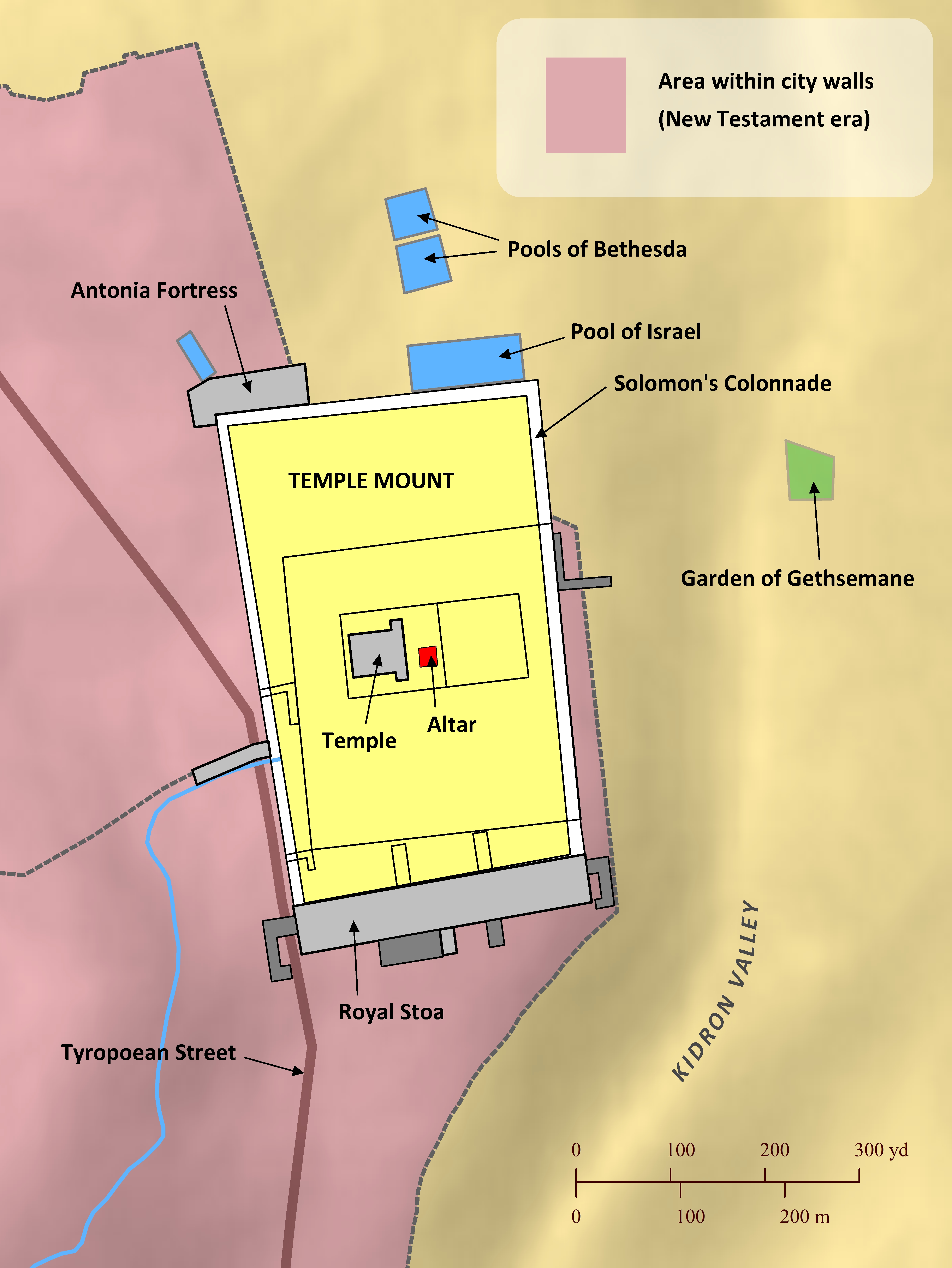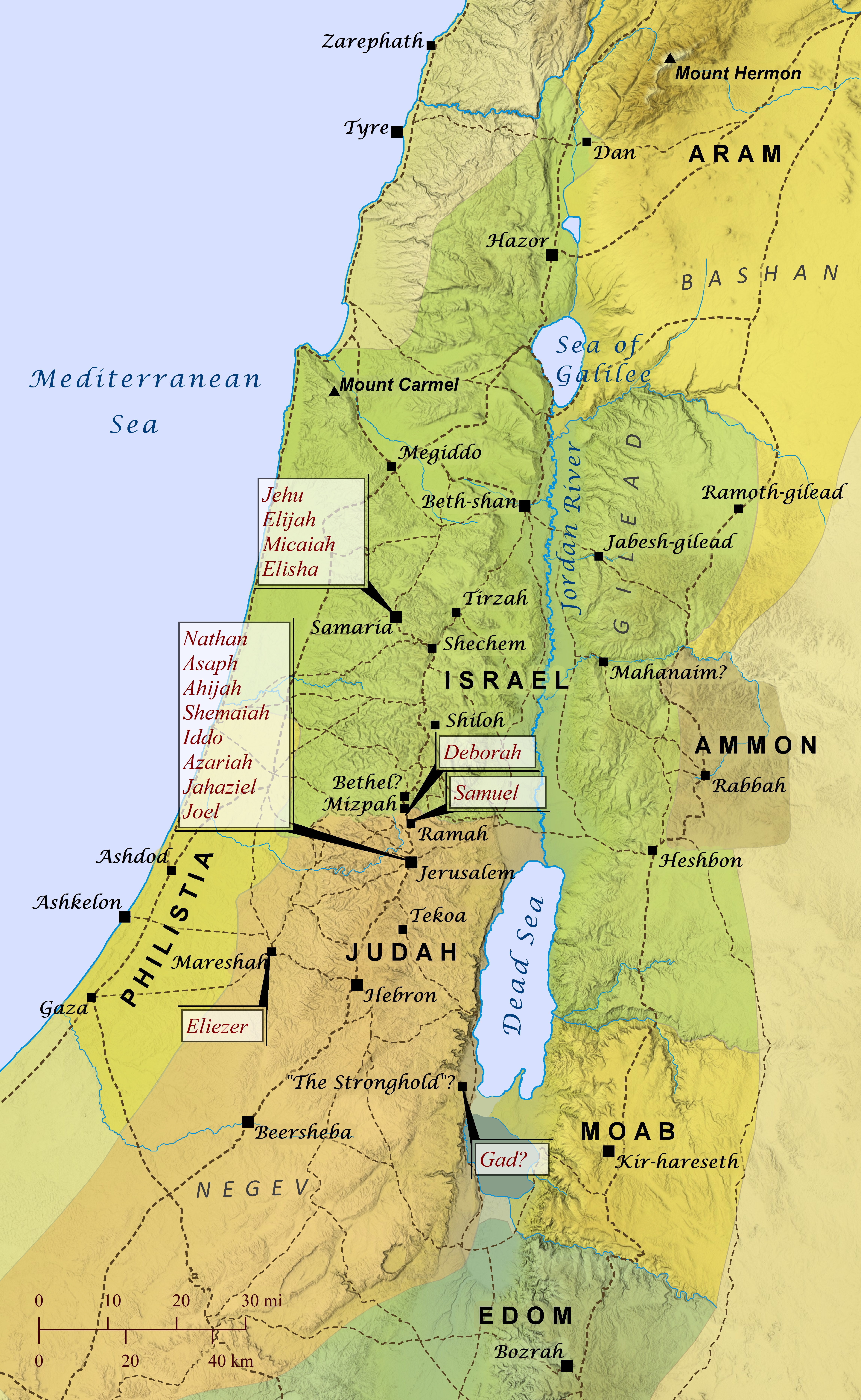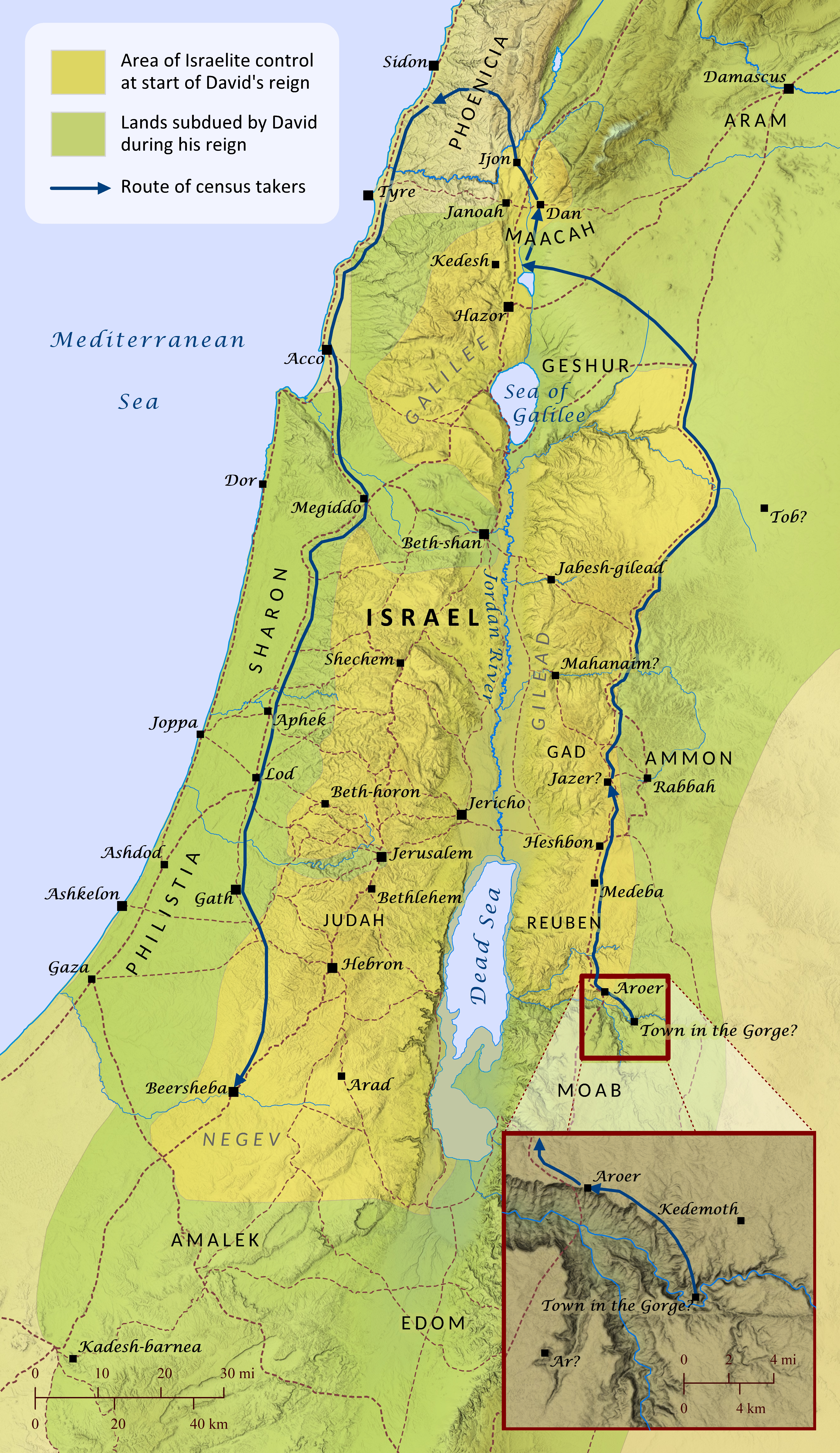
Temple of the Lord
The Temple of the Lord in Jerusalem, where all Israelite males were commanded to offer sacrifices to the Lord (Exodus 23:14-19; Deuteronomy 16:16-17), underwent several stages of reconstruction and development over hundreds of years. The first Temple was built by King Solomon to replace the aging Tabernacle, and it was constructed on a threshing floor on high ground on the north side of the city (2 Samuel 24; 1 Chronicles 21). Hundreds of years later King Hezekiah expanded the platform surrounding the Temple. When Jerusalem fell to the Babylonians in 586 B.C., the Temple was completely destroyed (2 Kings 25:1-21; 2 Chronicles 36:17-21; Jeremiah 39:1-10; 52:1-30). It was rebuilt in 515 B.C. after a group of Jews returned to Judea from exile in Babylon (Ezra 1:5-6:15; Nehemiah 7:5-65). Herod the Great completely rebuilt and expanded the Temple once again around 20 B.C., making it one of the largest temples in the Roman world. Jesus’ first believers often met together in Solomon’s Colonnade, a columned porch that encircled the Temple Mount, perhaps carrying on a tradition started by Jesus himself (John 10:23; Acts 3:11; 5:12). But Herod’s Temple did not last long: After many Jews revolted against Rome, the Romans eventually recaptured Jerusalem and destroyed the Temple in A.D. 70.

Prophets of the Old Testament before 800 B.C.
If you ask someone today what biblical prophets did, they will likely tell you that they divinely foretold of future events. While this was often the case, most prophets in the Bible focused as much on “forthtelling” God’s messages as they did on “foretelling” the future. That is, their primary role was to simply “forthtell” divinely acquired messages to leaders and groups of people, and at times that included foretelling of coming judgment, blessing, rescue, etc. Also, though plenty of prophets (sometimes called “seers” in Scripture) often spoke in confrontational or eccentric language that put them at odds with kings and religious leaders, the biblical writers also applied the term prophet to people who communicated God’s messages in ways that many readers today might not think of as prophecy, such as worship leaders appointed by David to “prophesy with lyres, harps, and cymbals” (1 Chronicles 25:1). Similarly, the books of Joshua, Judges, 1 & 2 Samuel, and 1 & 2 Kings are typically categorized as history by Christians, but in the Hebrew canon they belong to the category of Former Prophets. The Lord raised up prophets throughout all of biblical history, from the giving of the law under Moses to the revelation of the last days by the apostle John, and the kings of Israel and Judah often recognized and supported specific people as official prophets of the royal court and consulted them to find out God’s perspective about official matters. Following is a list of nearly everyone designated as prophet or seer in the Old Testament and the primary area of their ministry.
• Deborah (1216 B.C.) [Judges 4:4] => Baal-tamar?
• Samuel (1070 B.C.) [1 Samuel 3:20; 1 Chronicles 29:29; 2 Chronicles 35:18] => Ramah
• Gad (1018 B.C.) [2 Samuel 24:11; 1 Chronicles 21:9; 29:29; 2 Chronicles 29:25] => Masada?
• Nathan (1000 B.C.) [2 Samuel 12:1; 1 Chronicles 29:29; 2 Chronicles 29:25] => Jerusalem
• Asaph (1000 B.C.) [2 Chronicles 29:30] => Jerusalem
• Ahijah (935 B.C.) [1 Kings 11:29; 2 Chronicles 9:29] => Jerusalem
• Shemaiah (930 B.C.) [2 Chronicles 12:2-15] => Jerusalem
• Iddo (913 B.C.) [2 Chronicles 9:29; 12:15; 13:22] => Jerusalem
• Jehu son of Hanani (890 B.C.) [1 Kings 16:1-7; 2 Chronicles 19:2] => Samaria?
• Azariah (890 B.C.) [2 Chronicles 15:1-8] => Jerusalem
• Elijah (860 B.C.) [1 Kings 18:36] => Samaria
• Micaiah (853 B.C.) [1 Kings 22:8-23; 2 Chronicles 18:7-22] => Samaria
• Jahaziel (853 B.C.) [2 Chronicles 20:14] => Jerusalem
• Eliezer (853 B.C.) [2 Chronicles 20:37] => Mareshah
• Elisha (850 B.C.) [1 Kings 19:16; 2 Kings 2:15] => Samaria
• Joel (835 B.C.) [Joel 1:1] => Jerusalem

The Route of David’s Census Takers
2 Samuel 24:1-10; 1 Chronicles 21:1-8
After David had secured his reign over all Israel and greatly expanded his rule over neighboring nations, he commissioned Joab, the commander of his army, to “count the people of Israel and Judah.” Though Scripture does not explicitly state the reason for this order, the report that Joab provided to David nearly ten months later at the conclusion of the census makes his intentions clear: David was seeking a tally of all troops he had at his disposal throughout his kingdom. Joab initially resisted David’s order, and after the census was completed David was stricken with guilt over his actions, and ultimately the Lord punished Israel for David’s census. Yet nowhere in Scripture is the counting of troops clearly condemned. In fact, during the Israelites’ wanderings in the wilderness the Lord commanded two different censuses to be taken of Israel’s troops (Numbers 1; 26), and many of the accounts of Israel’s battles throughout the Old Testament include a careful tally of the troops involved, so it must have been normal practice to take a census such as David commissioned. Most scholars explain this discrepancy by inferring that Joab and others must have discerned that David was wrongly looking to military might instead of the Lord’s promise to fight for his people (Deuteronomy 20:1-4) or that he was disobeying the law by including those under twenty years of age (see Exodus 30:11-16; 1 Chronicles 27:23-24). While this may be true, it does not fully explain what this author has found to be a curious peculiarity about David’s census: The census takers do not appear to have traveled hardly anywhere within the core settlement areas of Israel or Judah. Instead, the census takers followed a route almost entirely along the perimeter of Israel’s core area of initial settlement, as shown on this map. They started out at Aroer and “the town in the middle of the gorge,” probably referring to modern Mudaynet as-Saliya in the Arnon Gorge (see also Deuteronomy 2:36; Joshua 13:9, 16), which were located at the far corner of Israel’s allotted land. Then they headed north to Jazer and Gilead, likely following the King’s Highway, which ran along the outer edge of Israel’s lands. Then they came to Tahtim-hodshi, which this author suspects is referring to the “lowlands of Kedesh.” The Israelite city of Kedesh was situated among the hills of upper Galilee, but just to the east of it lay a valley occupied primarily by the people of Maacah, who fought against and were defeated by David earlier in his reign. Then the census takers traveled to Dan, which is often cited along with Beersheba as marking the distant boundary of Israel (Judges 20:1; 1 Samuel 3:20; 2 Samuel 3:10; 17:11; 1 Chronicles 21:2), and on to Sidon and Tyre. The Bible never indicates that Sidon and Tyre were subdued by David, but he appears to have wielded considerable influence over Tyre (2 Samuel 5:11; 1 Chronicles 14:1; see also 1 Kings 5:2-11) and perhaps over Sidon as well. After this the census takers went to all the cities of the Hivites and Canaanites, likely indicating that they traveled through the coastal lands along the Mediterranean Sea. Lastly, they completed their route at the city of Beersheba in the Negev. This route along the perimeter of Israel’s core settlement areas suggests that, while David’s census takers were no doubt collecting troop information from the tribes of Israel (see 1 Chronicles 21:5-6), their primary focus appears to have been on David’s newly acquired lands, which would have been largely comprised of non-Israelites. This theory may also be supported by 2 Chronicles 2:17, which notes that “Solomon counted all the resident aliens who were in the land of Israel, after the census of them that David his father had taken.” Thus, this author suspects that Joab may have been urging David not to rely on troops from these non-Israelites to protect Israel and instead called upon the Lord to increase the number of “the people” (perhaps meaning the Israelite people) a hundredfold. At the same time, however, the biblical account of the census takers’ route never uses any of the names for the subdued nations (e.g., Moab, Ammon, Aram, Maacah, Philistia, etc.), though it does use vague references to “Canaanites” and “Hivites.” This may reflect a tension that existed at the time between David’s efforts to integrate these new lands into one great empire (thus explaining the aversion to identifying people by their former national affiliation) and the convictions of those like Joab, who may have been opposed to such integration.